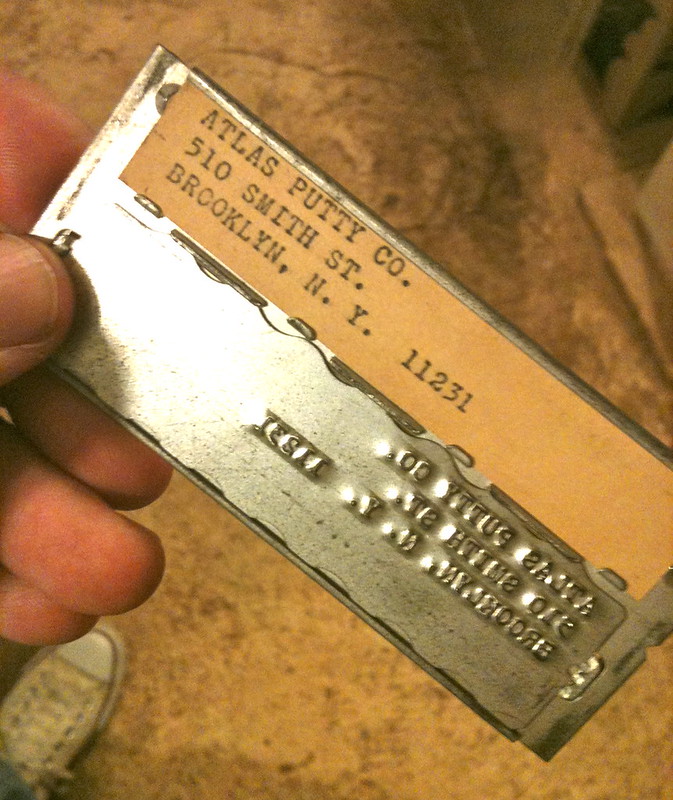
Yesterday I was walking around Brooklyn and heard someone call out, "Hey!" I turned and saw a carpenter named Gary, who I used to hang out with at a bar we both frequented. We hadn't seen each other in years, maybe longer (he admitted that he couldn't even remember my name, which is why he'd simply said, "Hey!"), so it was a nice surprise to encounter him there on the street.
Gary was standing in front of a storefront. "Is this your carpentry shop?" I asked. He said yes and offered to give me a quick tour. He was particularly eager to show me a bunch of artifacts that the shop's previous tenants had left behind in the basement, including a bunch of old stamping/embossing dies. Gary said they were for old-fashioned analog credit card machines (you know, the ones where the merchant would put your card in a metal bracket thingie and then run a slider over it), although I'm not convinced of that.
Whatever the dies were for, Gary had dozens of them, mostly for local businesses. One of them, shown above, really spoke to me -- "Atlas Putty Co." Sounds like the very embodiment of light-industrial Brooklyn, no? Since the address on the die includes a zip code, the die can't be all that old (zip codes weren't introduced until 1963 and didn't come into common usage until the early 1970s), but something about "Atlas Putty Co." has more of a 1930s or ’40s. feel to it. I suspect that's when the company was founded.
There's something inherently amusing about the word putty -- it feels sort of diminutive and playful. Is this simply because of the toy Silly Putty, or is it the word itself? In any case, the notion of an entire company devoted to putty seems endearingly quaint (although, of course, someone has to make the stuff).
From what I can tell, Atlas Putty is no longer operating in Brooklyn. Some quick internet searches came up dry, and Google Maps shows the address as a plain warehouse space.
There's a company called Atlas Putty in Illinois, however. This "other" Atlas has even snagged what is presumably the definitive putty-related web domain name, putty.com (although they haven't exactly made the most of it). Could this be the same company as the Brooklyn operation? Curious to find out, I called the Illinois Atlas, where the very pleasant woman who answered the phone told me, "No, we've always been here in Illinois."
So what became of the Atlas Putty in Brooklyn? If I spent a bit more time digging, I'm sure I could find out, but I don't have time for that right now, plus I kind of like it sometimes when things are left unresolved -- it's a little more mysterious that way, which lets us project our own imagined versions of what happened. Maybe Atlas Putty was a Mob front, for example (laundering cash via putty -- hey, stranger things have happened), and it went out of business when the owner was busted by the Feds. I'm gonna stick with that storyline until someone comes up with the real one.
Wondering when I'll get back to talking about report cards? Soon. This weekend I'm driving up to Connecticut to interview the son of Eva Greene, who attended the Manhattan Trade School for Girls nearly 100 years ago. She went on to work for her sister-in-law, Nettie Rosenstein, who was a famous fashion designer. Nettie is credited with having designed Mamie Eisenhower's 1953 inaugural ball dress, but I've been told that Eva -- the former Manhattan Trade student -- was actually doing most of the company's design work at that point, including the Mamie dress. I'm looking forward to hearing the full story this weekend.
Wondering when Slate will finally publish the next full-length Permanent Record article? You're not the only one. Grrrrr.

Neat find. I bet that your eyes lit up at the very thought of artifacts left in a basement.
ReplyDeleteThis is a plate for an old Addressograph machine.
ReplyDeleteBack in the pre-Internet dark ages, businesses, non-profits, schools and other institutions used them to imprint addresses on bulk mail. There were two units that made up the system. One was a keyer that you used to create the imprint on the metal plate. The other that was a printer loaded with a stack of these cards in a feed hopper. Some were manual, with the operator placing a fresh envelope on the print bed and pulling a lever for every imprint. Others were more automated.
My guess from the format of the card and presence of the zip code, is that this dates to sometime between 1965-1980. By the mid '80s maintenance of address mailing lists had migrated to early PCs, with labels printed out on pin-fed rolls of sticky-back paper.
My mother had an ancient credit card from an old (now defunct)department store. The card was metal and about the size of a soldier's dog tag.
ReplyDelete